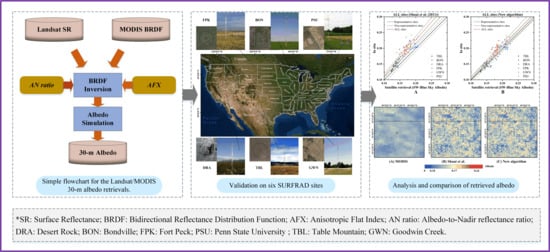An Algorithm for the Retrieval of High Temporal-Spatial Resolution Shortwave Albedo from Landsat-8 Surface Reflectance and MODIS BRDF
Abstract
:1. Introduction
2. Materials and Methods
2.1. Study Areas and Field Data
2.2. Satellite Data
2.3. Methods
2.3.1. Theoretical Basis to Retrieve Albedo
2.3.2. BRDF Inversion by Prior AN Ratio and AFX
2.3.3. Narrowband-to-Broadband Conversion
2.3.4. Landsat Albedo Modulation
2.4. Data Processing
2.4.1. Data Preparation
2.4.2. BRDF Inversion
2.4.3. Shortwave Albedo Generation
3. Results
3.1. Validation Results at SURFRAD
3.2. Comparison of Three Albedo Products
3.3. Capture Daily Surface Dynamics
4. Discussion
4.1. Performance Evaluation and Seasonal Deviation Analysis
4.2. Spatial Heterogeneity
4.3. Quality Control Suggestions and Limitations
4.4. Other Sources of Errors and Potential Improvements
5. Conclusions
- The results demonstrated that the new method had favorable usability and robustness, with less uncertainty (RMSE of 0.015 [8%]), less offset (mean bias of −0.005), and better accuracy (median deviation of −0.011) than CAP. In particular, the RMSE for non-representative sites was significantly improved, mainly by corrections for seasonal deviations.
- The new method can limit the seasonal deviations and capture subtle changes in surface albedo of an extended heterogeneous surface. As a result, the new method expands the capacity to retrieve albedo for complex heterogeneous surfaces, because the retrieval errors have been limited to each 500-m grid by prior BRDF knowledge, instead of accumulating with changes in spatial position.
- The new Landsat albedo product can accurately, finely, and continuously reveal more dynamic surface information. In addition, this simple operability could enable users to continuously and accurately retrieve albedo products with high spatial and temporal resolution in the absence of other auxiliary data (such as topography, land cover types, or disturbance of nature). Therefore, the new method is quite practical and thus very attractive.
Author Contributions
Funding
Institutional Review Board Statement
Informed Consent Statement
Data Availability Statement
Conflicts of Interest
Abbreviations
| AFX | Anisotropic Flat Index |
| AN ratio | Albedo-to-Nadir reflectance ratio |
| AVIRIS | Airborne Visible-InfraRed Imaging Spectrometer |
| BON | Bondville site |
| BRDF | Bidirectional Reflectance Distribution Function |
| BSA | Black-Sky Albedo |
| CAP | Concurrent Approach Product |
| DRA | Desert Rock site |
| EROS | Earth Resources Observation and Science |
| ESPA | EROS Processing Architecture |
| FPK | Fort Peck site |
| GWN | Goodwin Creek site |
| ISO data analysis | Iterative Self-Organizing data analysis |
| LaSRC | Land Surface Reflectance Code |
| LSN | Local Solar Noon |
| LUT | Look-Up Table |
| MODIS | MODerate Resolution Imaging Spectroradiometer |
| NASA | National Aeronautics and Space Administration |
| NIR | Near-infrared |
| NP | New albedo Product |
| NTB | Narrowband-to-Broadband |
| POLDER | Polarization and Directionality of the Earth Reflectance |
| PROBA-V | PROBA-VEGETATION |
| PSU | Penn State University site |
| RMSE | Root Mean Square Error |
| RSR | Relative Spectral Response |
| SEVIRI | Spinning Enhanced Visible and Infrared Imagers |
| STARFM | Spatial and Temporal Adaptive Reflectance Fusion Model |
| SURFRAD | Surface Radiation budget network |
| SW | Short-wave |
| SZA | Solar Zenith Angle |
| TBL | Table Mountain site |
| USGS | United States Geological Survey |
| VGT | VEGETATION |
| VIIRS | Visible Infrared Imaging Radiometer Suite |
| WSA | White-Sky Albedo |
References
- Dickinson, R.E. Land surface processes and climate—Surface albedos and energy balance. Adv. Geophys. 1983, 25, 305–353. [Google Scholar] [CrossRef]
- Dickinson, R.E. Land processes in climate models. Remote Sens. Environ. 1995, 51, 27–38. [Google Scholar] [CrossRef]
- Wang, S.; Davidson, A. Impact of climate variations on surface albedo of a temperate grassland. Agric. For. Meteorol. 2007, 142, 133–142. [Google Scholar] [CrossRef]
- Trenberth, K.E.; Fasullo, J.T.; Kiehl, J. Earth’s global energy budget. Bull. Am. Meteorol. Soc. 2009, 90, 311–323. [Google Scholar] [CrossRef]
- Loarie, S.R.; Lobell, D.B.; Asner, G.P.; Mu, Q.; Field, C.B. Direct impacts on local climate of sugar-cane expansion in Brazil. Nat. Clim. Chang. 2011, 1, 105–109. [Google Scholar] [CrossRef]
- Govaerts, Y.M.; Lattanzio, A.; Taberner, M.; Pinty, B. Generating global surface albedo products from multiple geostationary satellites. Remote Sens. Environ. 2008, 112, 2804–2816. [Google Scholar] [CrossRef]
- He, T.; Liang, S.; Yu, Y.; Wang, D.; Gao, F.; Liu, Q. Greenland surface albedo changes in July 1981–2012 from satellite observations. Environ. Res. Lett. 2013, 8, 044043. [Google Scholar] [CrossRef]
- Alibakhshi, S.; Naimi, B.; Hovi, A.; Crowther, T.W.; Rautiainen, M. Quantitative analysis of the links between forest structure and land surface albedo on a global scale. Remote Sens. Environ. 2020, 246, 111854. [Google Scholar] [CrossRef]
- Ye, S.; Feng, H.; Zou, B.; Ding, Y.; Zhu, S.; Li, F.; Dong, G. Satellite-based estimation of the influence of land use and cover change on the surface shortwave radiation budget in a humid basin. Remote Sens. 2021, 13, 1447. [Google Scholar] [CrossRef]
- An, Y.; Meng, X.; Zhao, L.; Li, Z.; Wang, S.; Shang, L.; Chen, H.; Lyu, S.; Li, G.; Ma, Y. Performance of GLASS and MODIS Satellite Albedo products in diagnosing Albedo variations during different time scales and special weather conditions in the Tibetan Plateau. Remote Sens. 2020, 12, 2456. [Google Scholar] [CrossRef]
- Cierniewski, J.; Roujean, J.L.; Jasiewicz, J.; Królewicz, S. Seasonal net shortwave radiation of bare arable land in Poland and Israel according to roughness and atmospheric irradiance. Remote Sens. 2021, 13, 1897. [Google Scholar] [CrossRef]
- Chen, C.; Tian, L.; Zhu, L.; Zhou, Y. The Impact of Climate Change on the Surface Albedo over the Qinghai-Tibet Plateau. Remote Sens. 2021, 13, 2336. [Google Scholar] [CrossRef]
- Carrer, D.; Ceamanos, X.; Roujean, J.L. Analysis of snow-free vegetation and bare soil albedos and application to numerical weather prediction. Int. Geosci. Remote Sens. Symp. 2013, 3789–3792. [Google Scholar] [CrossRef]
- Betts, R.A. Offset of the potential carbon sink from boreal forestation by decreases in surface albedo. Nature 2000, 408, 187–190. [Google Scholar] [CrossRef]
- Sellers, P.J.; Meeson, B.W.; Hall, F.G.; Asrar, G.; Murphy, R.E.; Schiffer, R.A.; Bretherton, F.P.; Dickinson, R.E.; Ellingson, R.G.; Field, C.B.; et al. Remote sensing of the land surface for studies of global change: Models-algorithms-experiments. Remote Sens. Environ. 1995, 51, 3–26. [Google Scholar] [CrossRef]
- Fletcher, C.G.; Kushner, P.J.; Hall, A.; Qu, X. Circulation responses to snow albedo feedback in climate change. Geophys. Res. Lett. 2009, 36, 2–5. [Google Scholar] [CrossRef] [Green Version]
- Bayat, C.B. GCOS The Global Observing System For Climate Implementation Needs. World Meteorol. Organ. 2016, 200, 316. [Google Scholar]
- Lucht, W.; Schaaf, C.B.; Strahler, A.H. An algorithm for the retrieval of albedo from space using semiempirical BRDF models. IEEE Trans. Geosci. Remote Sens. 2000, 38, 977–998. [Google Scholar] [CrossRef] [Green Version]
- Li, X.; Gao, F.; Wang, J.; Strahler, A. A priori knowledge accumulation and its application to linear BRDF model inversion. J. Geophys. Res. Atmos. 2001, 106, 925–935. [Google Scholar] [CrossRef]
- Schaaf, C.B.; Gao, F.; Strahler, A.H.; Lucht, W.; Li, X.; Tsang, T.; Strugnell, N.C.; Zhang, X.; Jin, Y.; Muller, J.; et al. First operational BRDF, albedo nadir reflectance products from MODIS. Remote Sens. Environ. 2002, 83, 135–148. [Google Scholar] [CrossRef] [Green Version]
- Pokrovsky, O.; Roujean, J.L. Land surface albedo retrieval via kernel-based BRDF modeling: I. Statistical inversion method and model comparison. Remote Sens. Environ. 2003, 84, 100–119. [Google Scholar] [CrossRef]
- Maignan, F.; Bréon, F.M.; Lacaze, R. Bidirectional reflectance of Earth targets: Evaluation of analytical models using a large set of spaceborne measurements with emphasis on the Hot Spot. Remote Sens. Environ. 2004, 90, 210–220. [Google Scholar] [CrossRef]
- Liu, Y.; Wang, Z.; Sun, Q.; Erb, A.M.; Li, Z.; Schaaf, C.B.; Zhang, X.; Román, M.O.; Scott, R.L.; Zhang, Q.; et al. Evaluation of the VIIRS BRDF, Albedo and NBAR products suite and an assessment of continuity with the long term MODIS record. Remote Sens. Environ. 2017, 201, 256–274. [Google Scholar] [CrossRef]
- He, T.; Liang, S.; Wang, D.; Shi, Q.; Tao, X. Estimation of high-resolution land surface shortwave albedo from AVIRIS data. IEEE J. Sel. Top. Appl. Earth Obs. Remote Sens. 2014, 7, 4919–4928. [Google Scholar] [CrossRef]
- Dominique, C.; Bruno, S.; Xavier, C.; Jean-Louis, R.; Roselyne, L. Copernicus Global Land Operations Vegetation and Energy CGLOPS-1, Framework Service Contract 199494; Algorithm Theoretical Basis Document, Issue 2.11. 2018. Available online: https://land.copernicus.eu/global/sites/cgls.vito.be/files/products/CGLOPS_ATBD_SA1km-V1_I2.11.pdf (accessed on 13 October 2021).
- Sánchez-Zapero, J.; Camacho, F.; Martínez-Sánchez, E.; Lacaze, R.; Carrer, D.; Pinault, F.; Benhadj, I.; Muñoz-Sabater, J. Quality assessment of PROBA-V surface Albedo V1 for the continuity of the copernicus climate change service. Remote Sens. 2020, 12, 2596. [Google Scholar] [CrossRef]
- Carrer, D.; Moparthy, S.; Lellouch, G.; Ceamanos, X.; Pinault, F.; Freitas, S.C.; Trigo, I.F. Land surface albedo derived on a ten daily basis from Meteosat Second Generation Observations: The NRT and climate data record collections from the EUMETSAT LSA SAF. Remote Sens. 2018, 10, 1262. [Google Scholar] [CrossRef] [Green Version]
- Amazirh, A.; Bouras, E.H.; Olivera-Guerra, L.E.; Er-Raki, S.; Chehbouni, A. Retrieving crop albedo based on radar sentinel-1 and random forest approach. Remote Sens. 2021, 13, 3181. [Google Scholar] [CrossRef]
- Kuusinen, N.; Stenberg, P.; Korhonen, L.; Rautiainen, M.; Tomppo, E. Structural factors driving boreal forest albedo in Finland. Remote Sens. Environ. 2016, 175, 43–51. [Google Scholar] [CrossRef]
- Wang, Z.; Erb, A.M.; Schaaf, C.B.; Sun, Q.; Liu, Y.; Yang, Y.; Shuai, Y.; Casey, K.A.; Román, M.O. Early spring post-fire snow albedo dynamics in high latitude boreal forests using Landsat-8 OLI data. Remote Sens. Environ. 2016, 185, 71–83. [Google Scholar] [CrossRef] [Green Version]
- Traversa, G.; Fugazza, D.; Senese, A.; Frezzotti, M. Landsat 8 oli broadband albedo validation in antarctica and greenland. Remote Sens. 2021, 13, 799. [Google Scholar] [CrossRef]
- Ren, S.; Miles, E.S.; Jia, L.; Menenti, M.; Kneib, M.; Buri, P.; McCarthy, M.J.; Shaw, T.E.; Yang, W.; Pellicciotti, F. Anisotropy parameterization development and evaluation for glacier surface albedo retrieval from satellite observations. Remote Sens. 2021, 13, 1714. [Google Scholar] [CrossRef]
- Kimes, D.S.; Sellers, P.J. Inferring hemispherical reflectance of the earth’s surface for global energy budgets from remotely sensed nadir or directional radiance values. Remote Sens. Environ. 1985, 18, 205–223. [Google Scholar] [CrossRef]
- Gao, F.; He, T.; Masek, J.G.; Shuai, Y.; Schaaf, C.B.; Wang, Z. Angular effects and correction for medium resolution sensors to support crop monitoring. IEEE J. Sel. Top. Appl. Earth Obs. Remote Sens. 2014, 7, 4480–4489. [Google Scholar] [CrossRef]
- Barnsley, M.J.; Strahler, A.H.; Morris, K.P.; Muller, J.P. Sampling the surface bidirectional reflectance distribution function (BRDF): 1. Evaluation of current and future satellite sensors. Remote Sens. Rev. 1994, 8, 271–311. [Google Scholar] [CrossRef]
- Plummer, S.; Lecomte, P.; Doherty, M. The ESA Climate Change Initiative (CCI): A European contribution to the generation of the Global Climate Observing System. Remote Sens. Environ. 2017, 203, 2–8. [Google Scholar] [CrossRef]
- Shuai, Y.; Masek, J.G.; Gao, F.; Schaaf, C.B. An algorithm for the retrieval of 30-m snow-free albedo from Landsat surface reflectance and MODIS BRDF. Remote Sens. Environ. 2011, 115, 2204–2216. [Google Scholar] [CrossRef]
- Zhang, K.; Zhou, H.; Wang, J.; Xue, H. Estimation and validation of high temporal and spatial resolution albedo. Int. Geosci. Remote Sens. Symp. 2013, 2888–2891. [Google Scholar] [CrossRef]
- Franch, B.; Vermote, E.F.; Claverie, M. Intercomparison of Landsat albedo retrieval techniques and evaluation against in situ measurements across the US SURFRAD network. Remote Sens. Environ. 2014, 152, 627–637. [Google Scholar] [CrossRef]
- Gao, B.; Gong, H.; Wang, T. A method for retrieving daily land surface albedo from space at 30-m resolution. Remote Sens. 2015, 7, 10951–10972. [Google Scholar] [CrossRef] [Green Version]
- Zhang, X.; Guo, J.; Xie, R.; Jiao, Z.; Dong, Y.; He, T.; Ding, A.; Yin, S.; Zhang, H.; Cui, L.; et al. Development of the Direct-Estimation Albedo Algorithm for Snow-Free Landsat TM Albedo Retrievals Using Field Flux Measurements. IEEE Trans. Geosci. Remote Sens. 2020, 58, 1550–1567. [Google Scholar] [CrossRef]
- Wang, Z.; Schaaf, C.B.; Sun, Q.; Kim, J.H.; Erb, A.M.; Gao, F.; Román, M.O.; Yang, Y.; Petroy, S.; Taylor, J.R.; et al. Monitoring land surface albedo and vegetation dynamics using high spatial and temporal resolution synthetic time series from Landsat and the MODIS BRDF/NBAR/albedo product. Int. J. Appl. Earth Obs. Geoinf. 2017, 59, 104–117. [Google Scholar] [CrossRef] [PubMed]
- Kuusinen, N.; Tomppo, E.; Shuai, Y.; Berninger, F. Effects of forest age on albedo in boreal forests estimated from MODIS and Landsat albedo retrievals. Remote Sens. Environ. 2014, 145, 145–153. [Google Scholar] [CrossRef]
- Abera, T.A.; Heiskanen, J.; Pellikka, P.K.E.; Adhikari, H.; Maeda, E.E. Climatic impacts of bushland to cropland conversion in Eastern Africa. Sci. Total Environ. 2020, 717, 137255. [Google Scholar] [CrossRef] [PubMed]
- Roman, M.O.; Gatebe, C.K.; Shuai, Y.; Wang, Z.; Gao, F.; Masek, J.G.; He, T.; Liang, S.; Schaaf, C.B. Use of in situ and airborne multiangle data to assess MODIS- and landsat-based estimates of directional reflectance and albedo. IEEE Trans. Geosci. Remote Sens. 2013, 51, 1393–1404. [Google Scholar] [CrossRef]
- Li, Z.; Erb, A.; Sun, Q.; Liu, Y.; Shuai, Y.; Wang, Z.; Boucher, P.; Schaaf, C. Preliminary assessment of 20-m surface albedo retrievals from sentinel-2A surface reflectance and MODIS/VIIRS surface anisotropy measures. Remote Sens. Environ. 2018, 217, 352–365. [Google Scholar] [CrossRef]
- Strugnell, N.C.; Lucht, W. An algorithm to infer continental-scale Albedo from AVHRR data, land over class, and field observation of typical BRDFs. J. Clim. 2001, 14, 1360–1376. [Google Scholar] [CrossRef]
- Strugnell, N.C.; Lucht, W.; Schaaf, C. A global albedo data set derived from AVHRR data for use in climate simulations. Geophys. Res. Lett. 2001, 28, 191–194. [Google Scholar] [CrossRef]
- Jiao, Z.; Zhang, H.; Dong, Y.; Liu, Q.; Xiao, Q.; Li, X. An algorithm for retrieval of surface Albedo from small view-angle airborne observations through the use of brdf archetypes as prior knowledge. IEEE J. Sel. Top. Appl. Earth Obs. Remote Sens. 2015, 8, 3279–3293. [Google Scholar] [CrossRef]
- Zhang, H.; Liu, P.; He, L.; Lian, Y.; Cui, T. Effects of reflectance anisotropy on albedo retrieval from satellite observations. Int. Geosci. Remote Sens. Symp. 2017, 2017, 3144–3154. [Google Scholar] [CrossRef]
- Gao, F.; Masek, J.; Schwaller, M.; Hall, F. On the blending of the landsat and MODIS surface reflectance: Predicting daily landsat surface reflectance. IEEE Trans. Geosci. Remote Sens. 2006, 44, 2207–2218. [Google Scholar] [CrossRef]
- Roy, D.P.; Ju, J.; Lewis, P.; Schaaf, C.; Gao, F.; Hansen, M.; Lindquist, E. Multi-temporal MODIS-Landsat data fusion for relative radiometric normalization, gap filling, and prediction of Landsat data. Remote Sens. Environ. 2008, 112, 3112–3130. [Google Scholar] [CrossRef]
- Hilker, T.; Wulder, M.A.; Coops, N.C.; Linke, J.; McDermid, G.; Masek, J.G.; Gao, F.; White, J.C. A new data fusion model for high spatial- and temporal-resolution mapping of forest disturbance based on Landsat and MODIS. Remote Sens. Environ. 2009, 113, 1613–1627. [Google Scholar] [CrossRef]
- Zurita-Milla, R.; Kaiser, G.; Clevers, J.G.P.W.; Schneider, W.; Schaepman, M.E. Downscaling time series of MERIS full resolution data to monitor vegetation seasonal dynamics. Remote Sens. Environ. 2009, 113, 1874–1885. [Google Scholar] [CrossRef]
- Zhu, X.; Chen, J.; Gao, F.; Chen, X.; Masek, J.G. An enhanced spatial and temporal adaptive reflectance fusion model for complex heterogeneous regions. Remote Sens. Environ. 2010, 114, 2610–2623. [Google Scholar] [CrossRef]
- Roy, D.P.; Zhang, H.K.; Ju, J.; Gomez-Dans, J.L.; Lewis, P.E.; Schaaf, C.B.; Sun, Q.; Li, J.; Huang, H.; Kovalskyy, V. A general method to normalize Landsat reflectance data to nadir BRDF adjusted reflectance. Remote Sens. Environ. 2016, 176, 255–271. [Google Scholar] [CrossRef] [Green Version]
- Liang, S.; Fang, H.; Chen, M.; Shuey, C.J.; Walthall, C.; Daughtry, C.; Morisette, J.; Schaaf, C.; Strahler, A. Validating MODIS land surface reflectance and albedo products: Methods and preliminary results. Remote Sens. Environ. 2002, 83, 149–162. [Google Scholar] [CrossRef]
- Jin, Y.; Schaaf, C.B.; Woodcock, C.E.; Gao, F.; Li, X.; Strahler, A.H.; Lucht, W.; Liang, S. Consistency of MODIS surface bidirectional reflectance distribution function and albedo retrievals: 1. Validation. J. Geophys. Res. Atmos. 2003, 108, 145–158. [Google Scholar] [CrossRef] [Green Version]
- Salomon, J.G.; Schaaf, C.B.; Strahler, A.H.; Gao, F.; Jin, Y. Validation of the MODIS Bidirectional Reflectance Distribution Function and albedo retrievals using combined observations from the Aqua and Terra platforms. IEEE Trans. Geosci. Remote Sens. 2006, 44, 1555–1564. [Google Scholar] [CrossRef]
- Liu, J.; Schaaf, C.; Strahler, A.; Jiao, Z.; Shuai, Y.; Zhang, Q.; Roman, M.; Augustine, J.A.; Dutton, E.G. Validation of moderate resolution imaging spectroradiometer (MODIS) albedo retrieval algorithm: Dependence of albedo on solar zenith angle. J. Geophys. Res. Atmos. 2009, 114, D01106. [Google Scholar] [CrossRef]
- Wang, Z.; Schaaf, C.B.; Strahler, A.H.; Chopping, M.J.; Román, M.O.; Shuai, Y.; Woodcock, C.E.; Hollinger, D.Y.; Fitzjarrald, D.R. Evaluation of MODIS albedo product (MCD43A) over grassland, agriculture and forest surface types during dormant and snow-covered periods. Remote Sens. Environ. 2014, 140, 60–77. [Google Scholar] [CrossRef] [Green Version]
- Román, M.O.; Schaaf, C.B.; Woodcock, C.E.; Strahler, A.H.; Yang, X.; Braswell, R.H.; Curtis, P.S.; Davis, K.J.; Dragoni, D.; Goulden, M.L.; et al. The MODIS (Collection V005) BRDF/albedo product: Assessment of spatial representativeness over forested landscapes. Remote Sens. Environ. 2009, 113, 2476–2498. [Google Scholar] [CrossRef] [Green Version]
- Shuai, Y.; Masek, J.G.; Gao, F.; Schaaf, C.B.; He, T. An approach for the long-term 30-m land surface snow-free albedo retrieval from historic Landsat surface reflectance and MODIS-based a priori anisotropy knowledge. Remote Sens. Environ. 2014, 152, 467–479. [Google Scholar] [CrossRef]
- Vermote, E.; Justice, C.; Claverie, M.; Franch, B. Preliminary analysis of the performance of the Landsat 8/OLI land surface reflectance product. Remote Sens. Environ. 2016, 185, 46–56. [Google Scholar] [CrossRef]
- Wang, Z.; Schaaf, C.; Lattanzio, A.; Carrer, D.; Grant, I.; Román, M.; Camacho, F.; Yu, Y.; Sánchez-Zapero, J.; Nickeson, J. Global Surface Albedo Product Validation Best Practices Protocol. Version 1.0. In Best Practice for Satellite Derived Land Product Validation: Land Product Validation Subgroup (WGCV/CEOS); Wang, Z., Nickeson, J., Román, M., Eds.; Land Product: Božice, Czech Republic, 2019. [Google Scholar] [CrossRef]
- Stroeve, J.; Box, J.E.; Wang, Z.; Schaaf, C.; Barrett, A. Re-evaluation of MODIS MCD43 greenland albedo accuracy and trends. Remote Sens. Environ. 2013, 138, 199–214. [Google Scholar] [CrossRef]
- Wang, Z.; Schaaf, C.B.; Sun, Q.; Shuai, Y.; Román, M.O. Capturing rapid land surface dynamics with Collection V006 MODIS BRDF/NBAR/Albedo (MCD43) products. Remote Sens. Environ. 2018, 207, 50–64. [Google Scholar] [CrossRef]
- Elmes, A.; Levy, C.; Erb, A.; Hall, D.K.; Scambos, T.A.; Digirolamo, N.; Schaaf, C. Consequences of the 2019 greenland ice sheet melt episode on albedo. Remote Sens. 2021, 13, 227. [Google Scholar] [CrossRef]
- Shuai, Y.; Schaaf, C.B.; Strahler, A.H.; Liu, J.; Jiao, Z. Quality assessment of BRDF/albedo retrievals in MODIS operational system. Geophys. Res. Lett. 2008, 35, 1–5. [Google Scholar] [CrossRef]
- Schaepman-Strub, G.; Schaepman, M.E.; Painter, T.H.; Dangel, S.; Martonchik, J.V. Reflectance quantities in optical remote sensing-definitions and case studies. Remote Sens. Environ. 2006, 103, 27–42. [Google Scholar] [CrossRef]
- Roujean, J.L.; Leroy, M.; Dechamps, P. A bidirectional reflectance model of the Earth’s surface for the correction of remote sensing data. J. Geophys. Res. Atmos. 1992, 97, 20455–20468. [Google Scholar] [CrossRef]
- Wanner, W.; Li, X.; Strahler, A.H. On the derivation of kernels for kernel-driven models of bidirectional reflectance. J. Geophys. Res. Atmos. 1995, 100, 21077–21089. [Google Scholar] [CrossRef]
- Li, X.; Gao, F.; Chen, L.; Strahler, A.H. Derivation and validation of a new kernel for kernel-driven BRDF models. Remote Sens. Earth Sci. Ocean. Sea Ice Appl. 1999, 3868, 368. [Google Scholar] [CrossRef]
- Lewis, P.; Barnsley, M. Influence of the sky radiance distribution on various formulations of the earth surface albedo. Proc. Conf. Phys. Meas. Signat. Remote Sens. 1994, pp. 707–715. Available online: http://www2.geog.ucl.ac.uk/~plewis/LewisBarnsley1994.pdf (accessed on 13 October 2021).
- Román, M.O.; Schaaf, C.B.; Lewis, P.; Gao, F.; Anderson, G.P.; Privette, J.L.; Strahler, A.H.; Woodcock, C.E.; Barnsley, M. Assessing the coupling between surface albedo derived from MODIS and the fraction of diffuse skylight over spatially-characterized landscapes. Remote Sens. Environ. 2010, 114, 738–760. [Google Scholar] [CrossRef]
- Deering, D.W.; Eck, T.F.; Grier, T. Shinnery Oak Bidirectional Reflectance Properties and Canopy Model Inversion. IEEE Trans. Geosci. Remote Sens. 1992, 30, 339–348. [Google Scholar] [CrossRef]
- Deering, D.W.; Eck, T.F.; Banerjee, B. Characterization of the reflectance anisotropy of three Boreal forest canopies in spring-summer. Remote Sens. Environ. 1999, 67, 205–229. [Google Scholar] [CrossRef]
- He, T.; Liang, S.; Wang, D.; Cao, Y.; Gao, F.; Yu, Y.; Feng, M. Evaluating land surface albedo estimation from Landsat MSS, TM, ETM +, and OLI data based on the unified direct estimation approach. Remote Sens. Environ. 2018, 204, 181–196. [Google Scholar] [CrossRef]
- Jiao, Z.; Hill, M.J.; Schaaf, C.B.; Zhang, H.; Wang, Z.; Li, X. An anisotropic flat index (AFX) to derive BRDF archetypes from MODIS. Remote Sens. Environ. 2014, 141, 168–187. [Google Scholar] [CrossRef]
- Zhang, H.; Jiao, Z.; Dong, Y.; Li, X. Evaluation of BRDF archetypes from MODIS multi-angular observations. IEEE Geosci. Remote Sens. Symposium. 2014, 4738–4741. [Google Scholar] [CrossRef]
- Zhang, H.; Jiao, Z.; Dong, Y.; Li, X. Evaluation of BRDF archetypes for representing surface reflectance anisotropy using MODIS BRDF data. Remote Sens. 2015, 7, 7826–7845. [Google Scholar] [CrossRef] [Green Version]
- Liang, S.; Shuey, C.J.; Russ, A.L.; Fang, H.; Chen, M.; Walthall, C.L.; Daughtry, C.S.T.; Hunt, R. Narrowband to broadband conversions of land surface albedo: II. Validation. Remote Sens. Environ. 2003, 84, 25–41. [Google Scholar] [CrossRef]
- Gao, B.; Jia, L.; Wang, T. Derivation of land surface albedo at high resolution by combining HJ-1A/B reflectance observations with MODIS BRDF products. Remote Sens. 2014, 6, 8966–8985. [Google Scholar] [CrossRef] [Green Version]
- Cescatti, A.; Marcolla, B.; Santhana Vannan, S.K.; Pan, J.Y.; Román, M.O.; Yang, X.; Ciais, P.; Cook, R.B.; Law, B.E.; Matteucci, G.; et al. Intercomparison of MODIS albedo retrievals and in situ measurements across the global FLUXNET network. Remote Sens. Environ. 2012, 121, 323–334. [Google Scholar] [CrossRef] [Green Version]
- Hao, D.; Wen, J.; Xiao, Q.; You, D.; Tang, Y. An Improved Topography-Coupled Kernel-Driven Model for Land Surface Anisotropic Reflectance. IEEE Trans. Geosci. Remote Sens. 2020, 58, 2833–2847. [Google Scholar] [CrossRef]

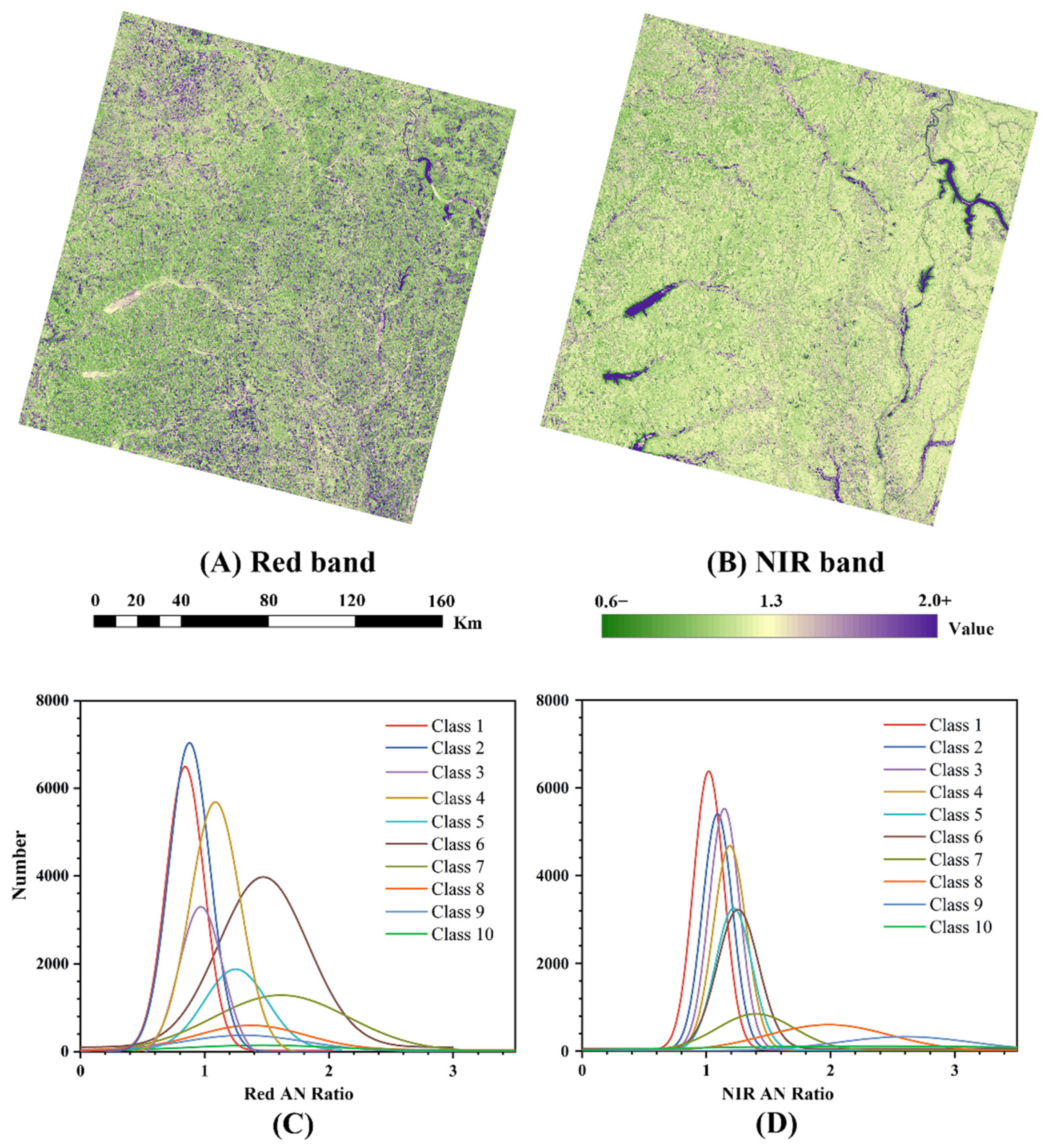
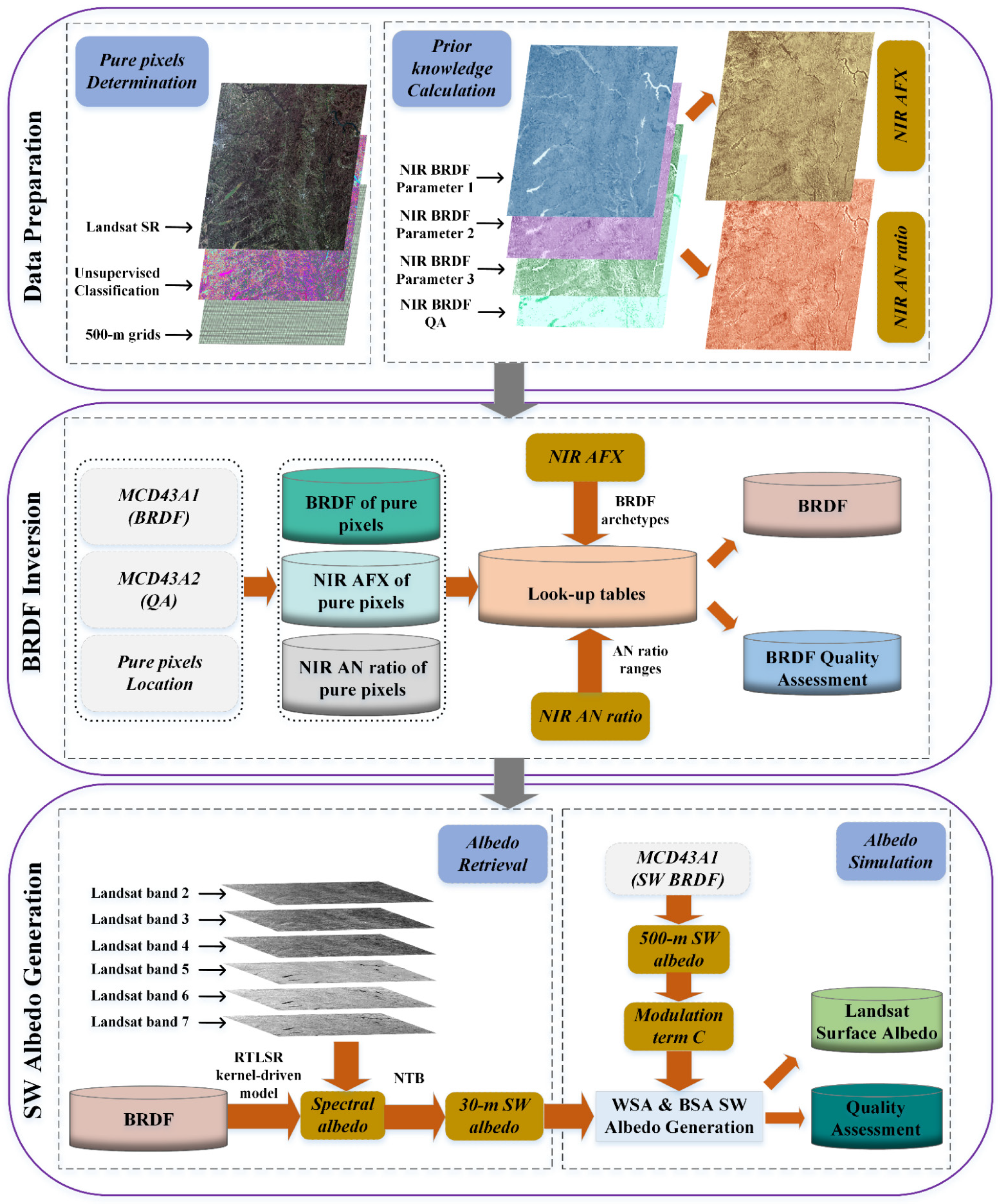

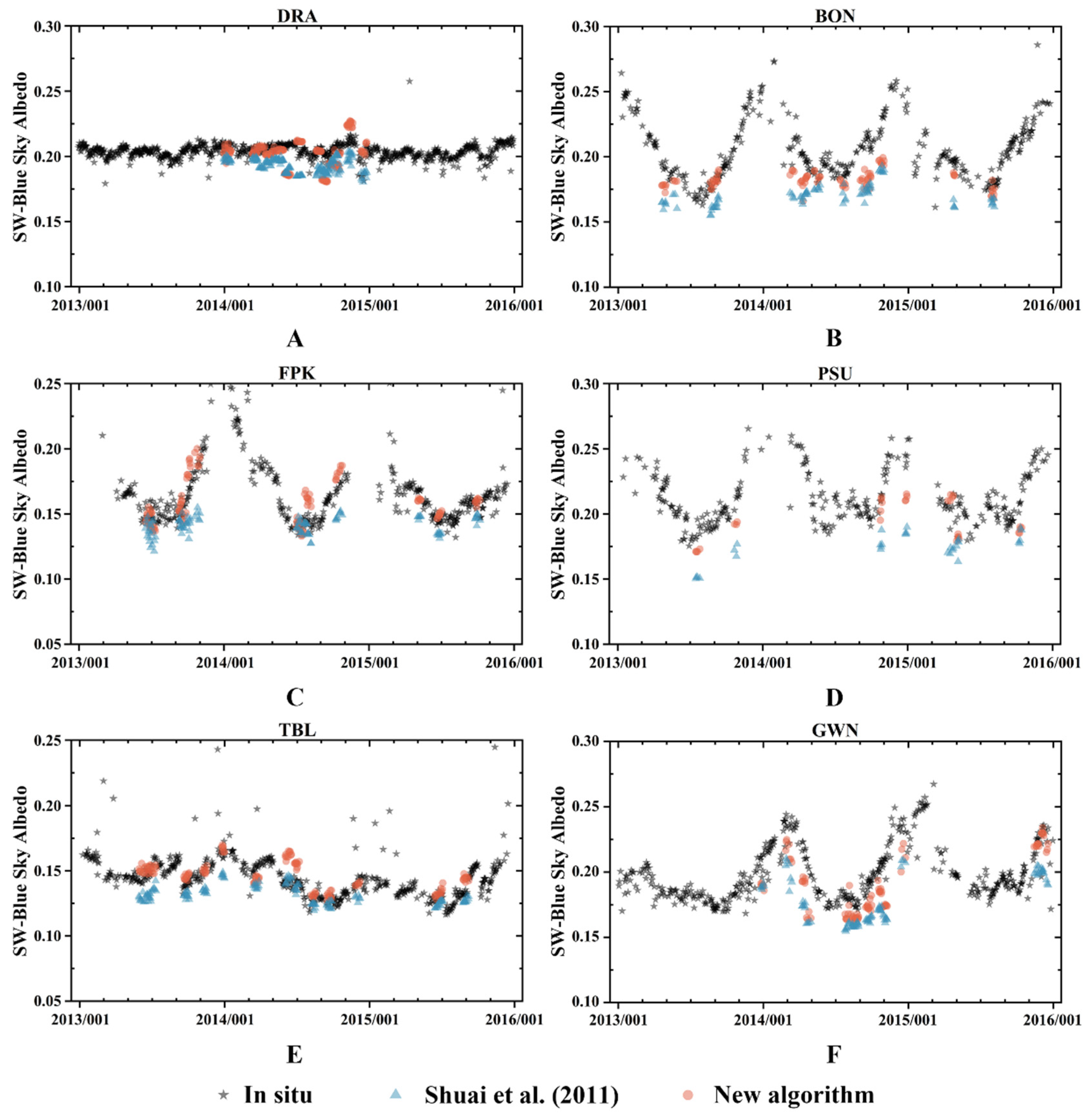
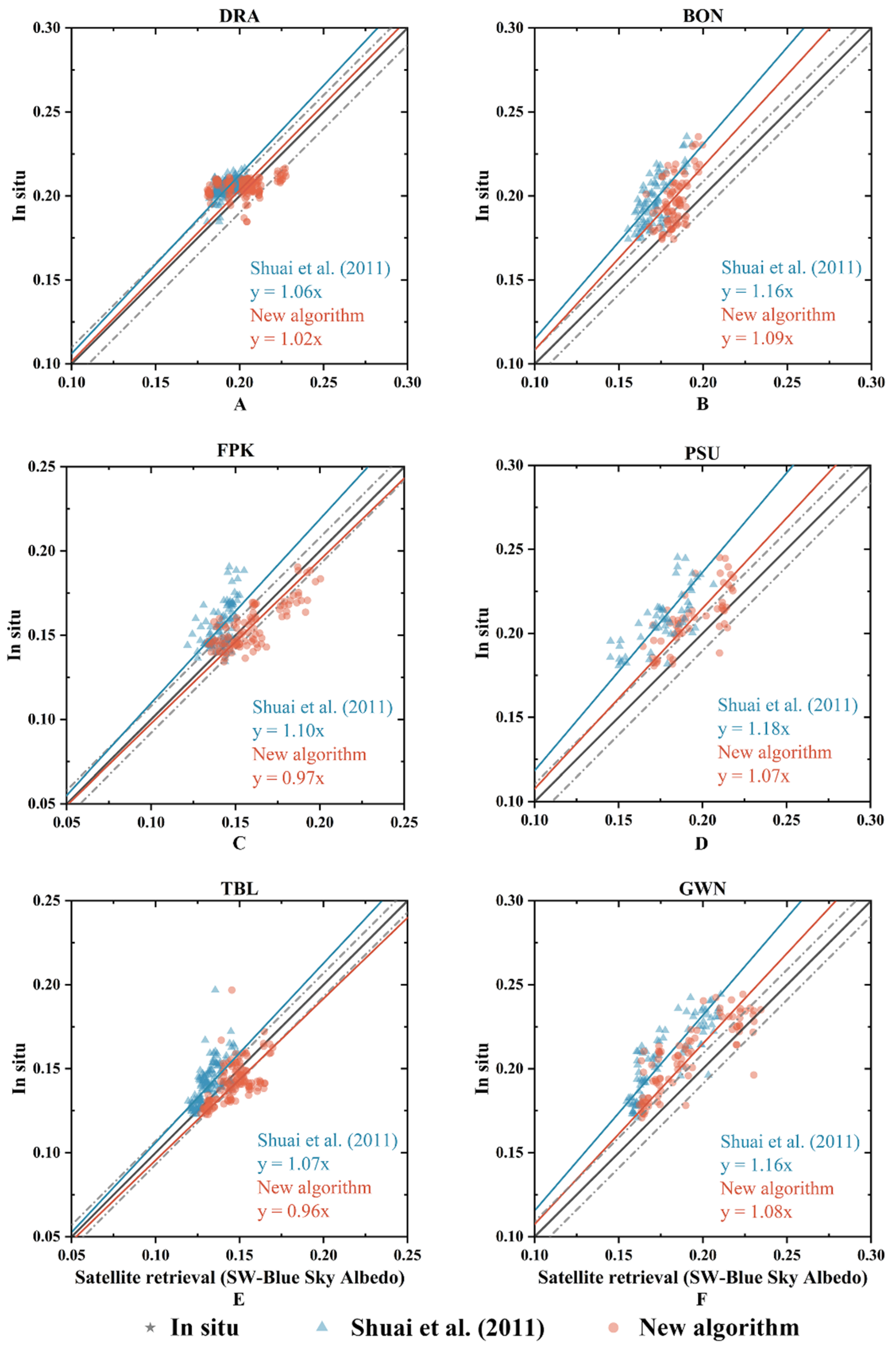
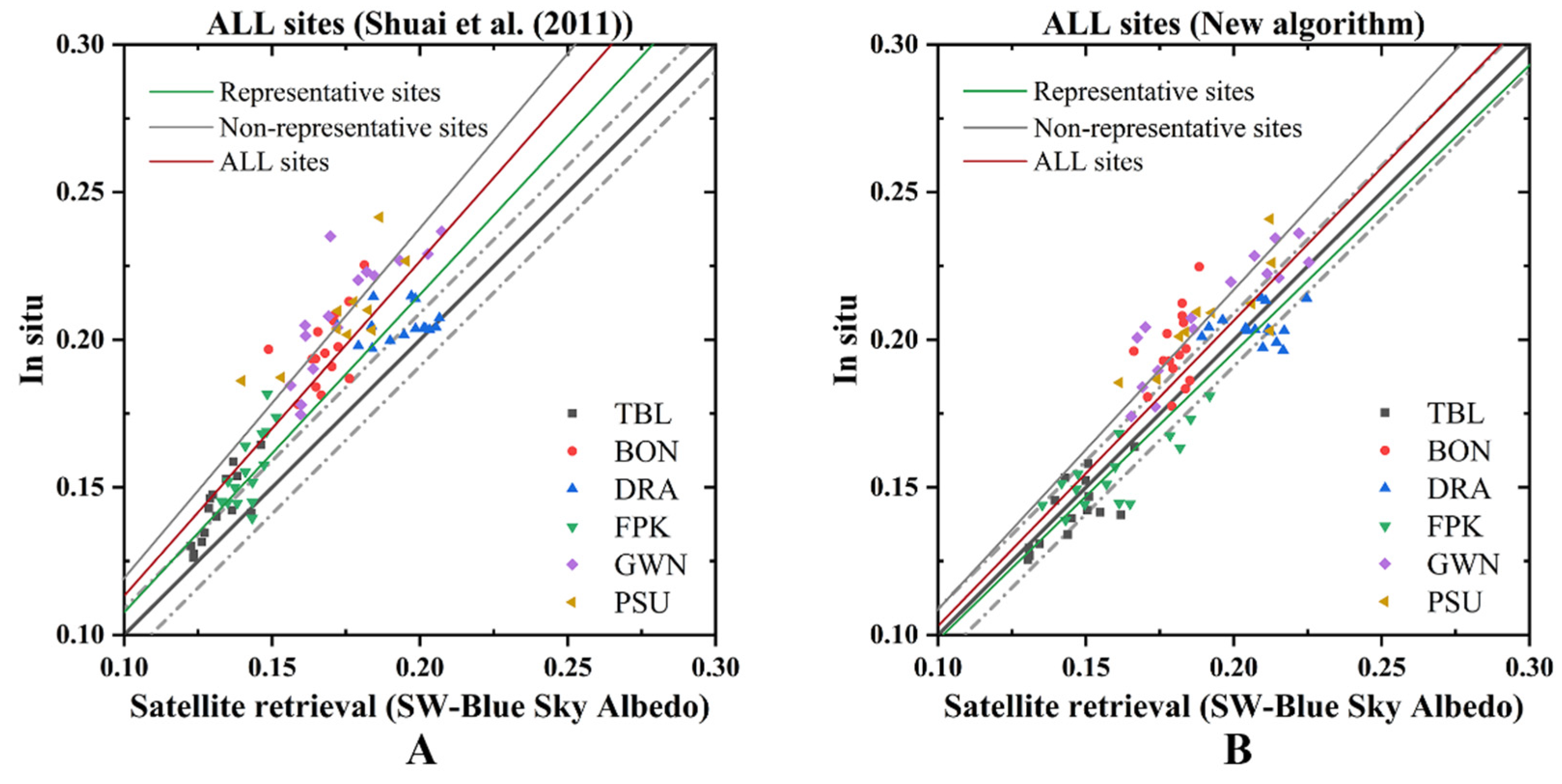
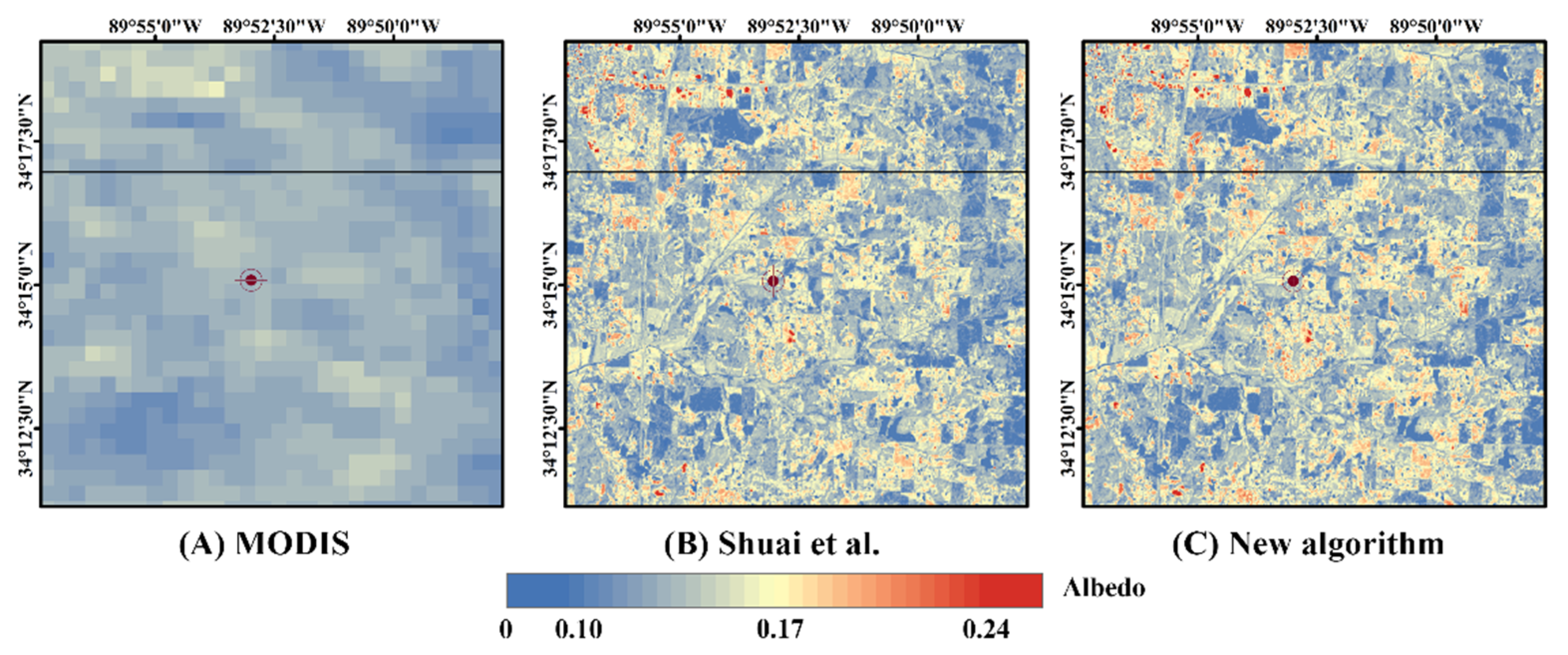
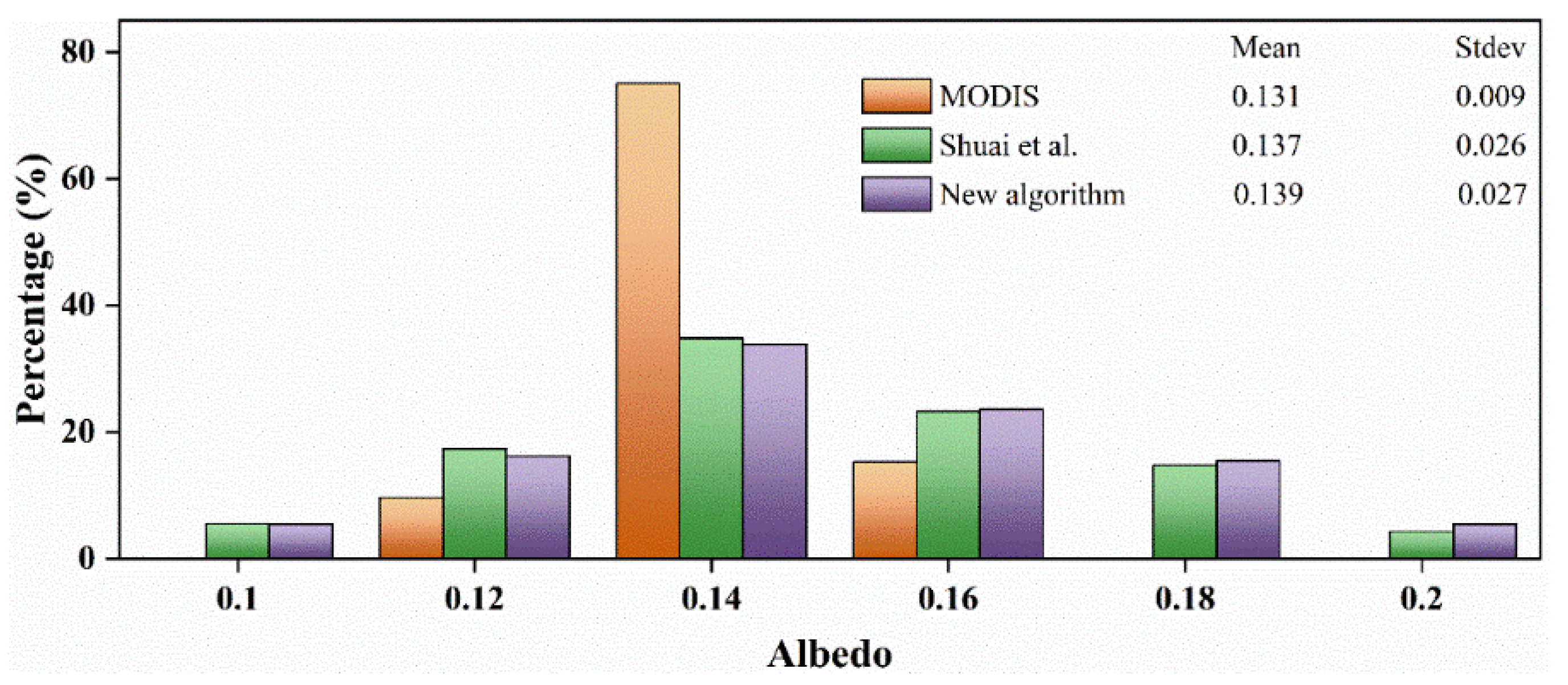
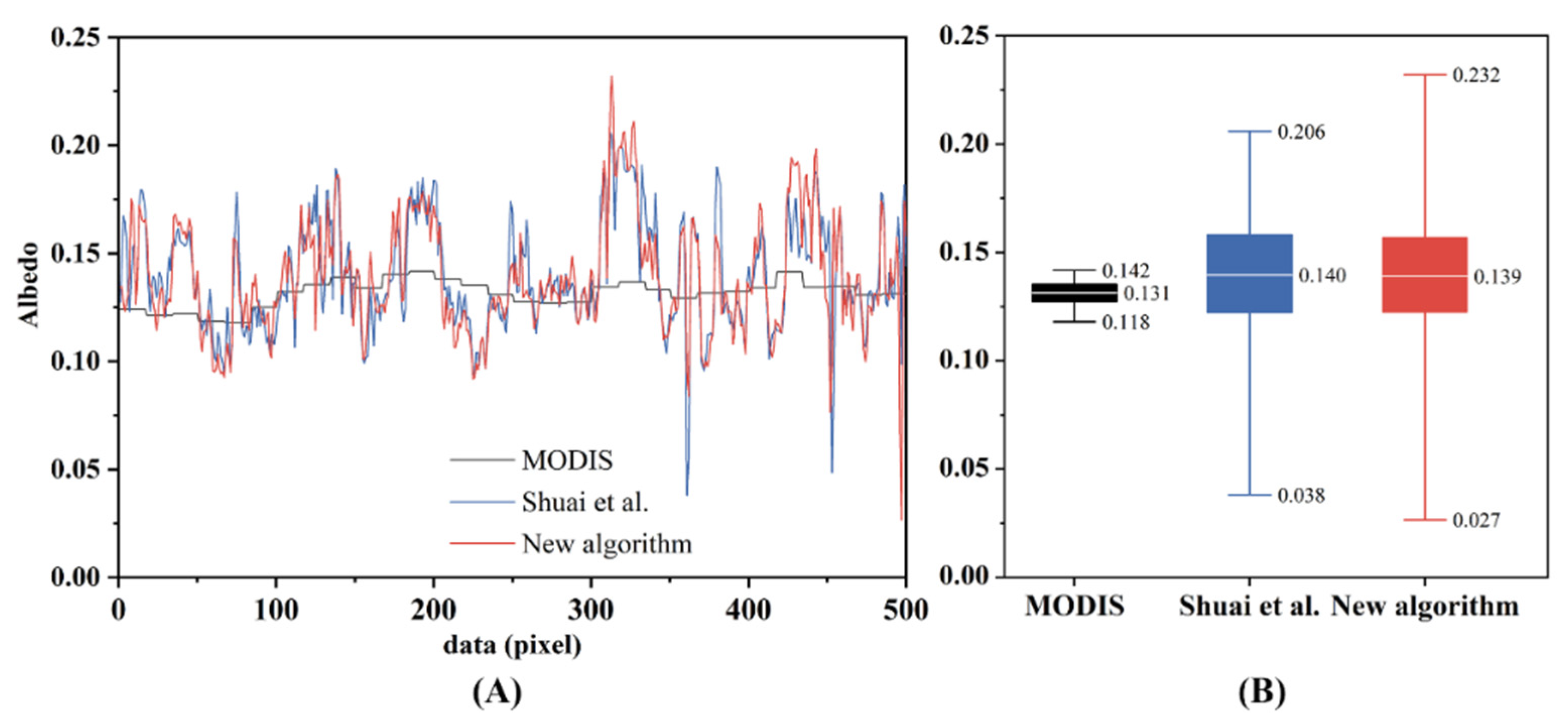
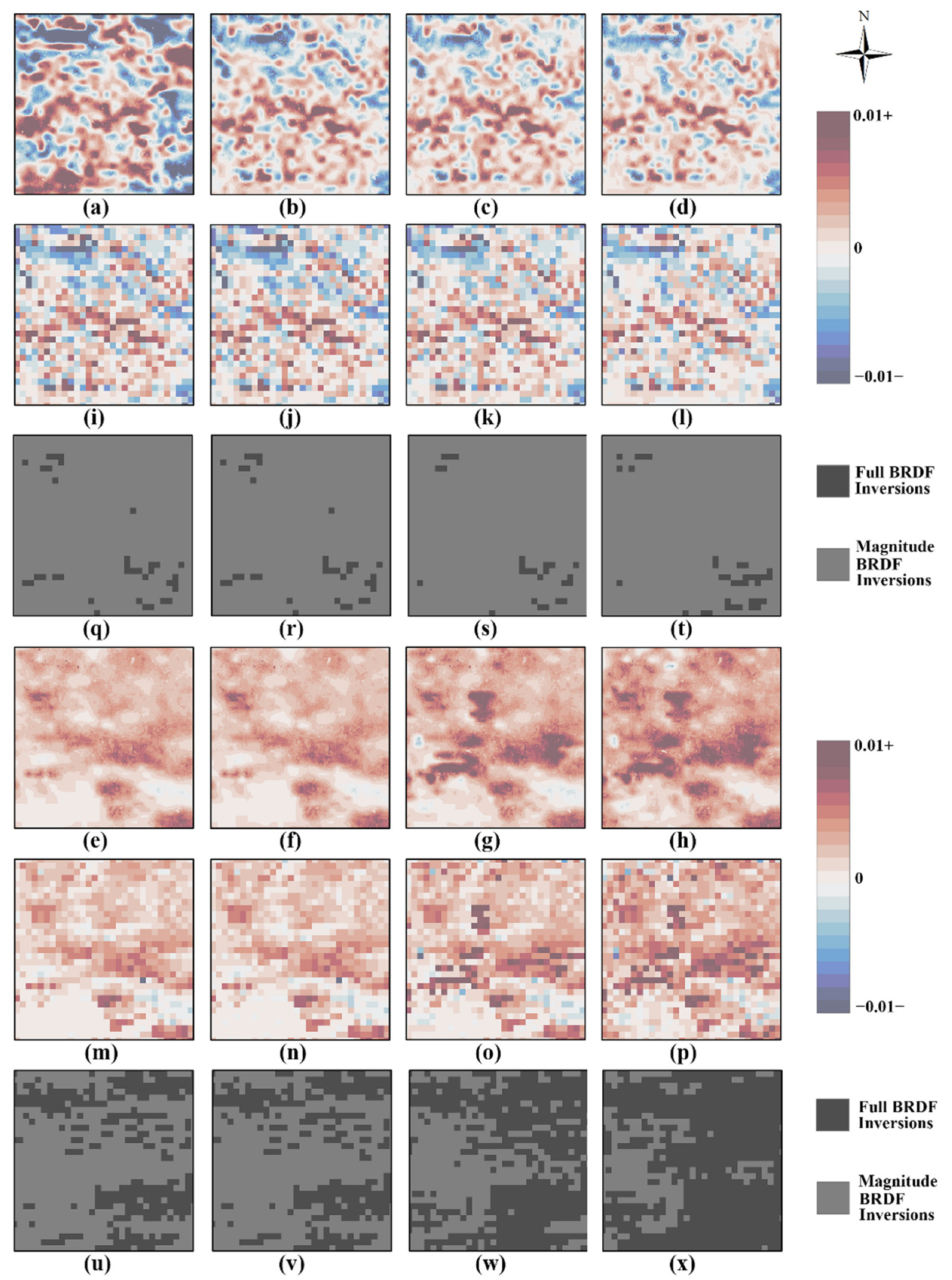
| Site Name 1 | Site ID | Latitude Longitude | Land Cover Type | Landsat Path/Row | Scenes 2 |
|---|---|---|---|---|---|
| Table Mountain | TBL | 40.1256′N, 105.2378′W | Grassland | 34/32, 33/32 | 15 |
| Desert Rock | DRA | 36.6232′N, 116. 0196′W | Sparse vegetation, desert | 40/34, 40/35 | 15 |
| Fort Peck | FPK | 48.3080′N, 105.1018′W | Grassland | 35/26, 36/26 | 15 |
| Goodwin | GWN | 34.2547′N, 89.8729′W | Grassland, deciduous trees | 23/36, 22/36 | 15 |
| Penn State | PSU | 40.7203′N, 77.9310′W | Agriculture | 16/32 | 10 |
| Bondville | BON | 40.0516′N, 88.3733′W | Agriculture | 23/32, 22/32 | 15 |
| MODIS | Landsat-8 OLI |
|---|---|
| Band 1 (0.620–0.670 μm) | Band 4 (0.636–0.673 μm) |
| Band 2 (0.841–0.876 μm) | Band 5 (0.851–0.879 μm) |
| Band 3 (0.459–0.479 μm) | Band 2 (0.452–0.512 μm) |
| Band 4 (0.545–0.565 μm) | Band 3 (0.533–0.590 μm) |
| Band 6 (1.628–1.652 μm) | Band 6 (1.566–1.651 μm) |
| Band 7 (2.105–2.155 μm) | Band 7 (2.107–2.294 μm) |
| Cases | Representation | AFX | AN Ratio | Quality Labels | Meaning |
|---|---|---|---|---|---|
| A | Y | Y | Y | 0 | High quality |
| B | Y | Y | N | 1 | Good quality |
| C | Y | N | Y | 1 | Good quality |
| D | Y | N | N | 2 | Low quality |
| E | N | N/A1 | N/A | 2 | Low quality |
| F | N/A | N/A | N/A | 15 | NULL |
| Band | AFX Range | Mean AFX |
|---|---|---|
| NIR | [0.541, 0.804] | 0.744 |
| [0.804, 0.896] | 0.853 | |
| [0.896, 0.966] | 0.931 | |
| [0.966, 1.042] | 1.002 | |
| [1.042, 1.142] | 1.091 | |
| [1.142, 1.361] | 1.203 |
| Site ID# | Samples | Concurrent Approach | New Algorithm | |||||||||
|---|---|---|---|---|---|---|---|---|---|---|---|---|
| RMSE | Median Deviation | Mean Bias | R2 | Slope | RMSE | Median Deviation | Mean Bias | R2 | Slope | |||
| A | DRA | 177 | 0.013 | −0.010 | −0.011 | 0.67 | 1.06 | 0.012 | 0.003 | −0.002 | 0.39 | 1.02 |
| FPK | 103 | 0.017 | −0.008 | −0.013 | 0.71 | 1.10 | 0.011 | 0.005 | 0.004 | 0.81 | 0.97 | |
| TBL | 131 | 0.014 | −0.012 | −0.011 | 0.81 | 1.07 | 0.011 | 0.004 | 0.002 | 0.75 | 0.96 | |
| Representative sites | 311 | 0.015 | −0.014 | −0.012 | 0.96 | 1.07 | 0.011 | 0.004 | 0.002 | 0.94 | 0.98 | |
| B | BON | 83 | 0.029 | −0.026 | −0.027 | 0.74 | 1.16 | 0.018 | −0.013 | −0.014 | 0.61 | 1.09 |
| GWN | 89 | 0.030 | −0.033 | −0.029 | 0.84 | 1.16 | 0.019 | −0.021 | −0.015 | 0.83 | 1.08 | |
| PSU | 31 | 0.034 | −0.032 | −0.032 | 0.81 | 1.18 | 0.020 | −0.016 | −0.015 | 0.82 | 1.07 | |
| Non-representative sites | 206 | 0.032 | −0.032 | −0.030 | 0.77 | 1.18 | 0.020 | −0.019 | −0.015 | 0.78 | 1.09 | |
| All six sites | 517 | 0.026 | −0.028 | −0.018 | 0.90 | 1.13 | 0.015 | −0.011 | −0.005 | 0.91 | 1.03 | |
| Date | 04/05 | 04/06 | 04/07 | 04/08 | 04/10 | 04/11 | 04/12 | 04/13 |
|---|---|---|---|---|---|---|---|---|
| MODIS mean albedo | 0.131 | 0.131 | 0.131 | 0.131 | 0.133 | 0.133 | 0.134 | 0.134 |
| Landsat mean albedo | 0.138 | 0.139 | 0.139 | 0.139 | 0.140 | 0.140 | 0.141 | 0.142 |
| R2 | 0.76 | 0.87 | 0.87 | 0.86 | 0.81 | 0.79 | 0.71 | 0.71 |
Publisher’s Note: MDPI stays neutral with regard to jurisdictional claims in published maps and institutional affiliations. |
© 2021 by the authors. Licensee MDPI, Basel, Switzerland. This article is an open access article distributed under the terms and conditions of the Creative Commons Attribution (CC BY) license (https://creativecommons.org/licenses/by/4.0/).
Share and Cite
Yang, G.; Wang, J.; Xiong, J.; Yong, Z.; Ye, C.; Sun, H.; Liu, J.; Duan, Y.; He, Y.; He, W. An Algorithm for the Retrieval of High Temporal-Spatial Resolution Shortwave Albedo from Landsat-8 Surface Reflectance and MODIS BRDF. Remote Sens. 2021, 13, 4150. https://doi.org/10.3390/rs13204150
Yang G, Wang J, Xiong J, Yong Z, Ye C, Sun H, Liu J, Duan Y, He Y, He W. An Algorithm for the Retrieval of High Temporal-Spatial Resolution Shortwave Albedo from Landsat-8 Surface Reflectance and MODIS BRDF. Remote Sensing. 2021; 13(20):4150. https://doi.org/10.3390/rs13204150
Chicago/Turabian StyleYang, Gang, Jiyan Wang, Junnan Xiong, Zhiwei Yong, Chongchong Ye, Huaizhang Sun, Jun Liu, Yu Duan, Yufeng He, and Wen He. 2021. "An Algorithm for the Retrieval of High Temporal-Spatial Resolution Shortwave Albedo from Landsat-8 Surface Reflectance and MODIS BRDF" Remote Sensing 13, no. 20: 4150. https://doi.org/10.3390/rs13204150
APA StyleYang, G., Wang, J., Xiong, J., Yong, Z., Ye, C., Sun, H., Liu, J., Duan, Y., He, Y., & He, W. (2021). An Algorithm for the Retrieval of High Temporal-Spatial Resolution Shortwave Albedo from Landsat-8 Surface Reflectance and MODIS BRDF. Remote Sensing, 13(20), 4150. https://doi.org/10.3390/rs13204150





